News from Haiti: Vol. 10 part 1: Haiti and Japan
Japan-Haiti Relations (Focusing on Economic Cooperation)
It has been 63 years since diplomatic relations restarted with Haiti (April, 1956), and 44 years since the opening of the Japanese Embassy in Haiti (1975).
During this time, Japan and Haiti have shared a number of common values and world views; they have built an excellent bilateral relationship without any political conflict or matters of concern.
On a personal note, I left my post of Ambassador to Haiti in the beginning of 2019, and as such I would like to give a mainly government-related overview of the three years and three months that I spent as Ambassador, and talk about the continually pulsating days in office, as well as about the continuing friendly bilateral ties. The Japanese embassy in Haiti is involved in bilateral diplomatic and political relationship, exchange visits of official dignitaries, economic relations, government-sponsored exchange student programs for personnel and technical training, introducing Japanese culture and food, wine, etc. for promoting a deeper understanding of Japan, and other activities; in this column I would like to focus on the economic cooperation side of the Japanese government’s efforts.
1.Economic Cooperation (Overview)
Currently, the most major exchange between Japan-Haiti is Japan’s ODA (Overseas Development Assistance). As I have mentioned in previous columns, because of the existing huge needs for Haiti to maintain and develop its political, economic, and social functions, doing this all by itself is not a reasonable approach. Somewhere the negative economic and social spiral must be converted into a positive spiral, and the international community is making efforts with Haiti in getting to that point in the shortest amount of time possible. The UN, World Bank, IMF, IDB, OAS and many other international organizations, diplomatic corps (traditionally, the dean of the diplomatic corps is the Vatican, along with other nations such as the United States, Canada, France, and other European, Central and South American nations) are giving support and cooperation in various shapes and sizes to Haiti. Within this environment, Japan has also agreed upon central issues and a cooperation strategy to steadily maintain and develop cooperative bilateral ties with Haiti.
The history of economic cooperation between Japan and other nations is long and many people already have deep knowledge on the significance and meaning of this type of cooperation. However, I think it is also true that, including methodology, there are diverse opinions, including positive and negative. To make a simple general overview right here, economic cooperation is a way to build friendly relations with other nations as a part of promoting a nation’s diplomatic relations. Also, when looking at events on a global scale, taking the positive elements (related to: economy, trade, industry) and negative elements (related to: environment, disease, human rights, conflict, etc.) and in order to either share them in a better form or to reduce them, cooperation between developed nations and developing nations is vital for both parties. I also believe the school of thought that says at the core of this is a nation’s duty in some cases. There are already internationally-established rules for the development cooperation, and in Japan it ranges from approaches, modalities, guidelines and policies, all the way to cooperative -implementation systems in place, and upon these, plan proposals have been made and systematically implemented.
When visiting local sites, there are a lot of questions as to why countries cooperate together on economic cooperation, and why other bodies give them financial support. These questions usually come from students and children when making visits to local schools. It may seem like a very natural question, but it is a fundamental question which has an infinite number of answers depending on whom one asks. Here are some sample answers to the above question: 1. There are people who are in trouble and/or who need help, and we must help them. This answer is from people who have a basic sense that it is natural to help as a fellow human being. 2. In a bilateral relationship, it is natural for a country that has particular economic and/or technical abilities to share those with others for appropriate distribution of resources from a worldwide point of view. 3. Delving further into number two, as an international society we should take a global perspective, and taking responsibility is an apparent common sense. 4. More strategically speaking, economic cooperation is a tool used in bilateral relations.
Of course, there are many other explanations apart from the above.
There are elements in all of the reasons above, but taking the opposite view, this type of cooperation is taking place because there are bilateral ties (diplomatic relations) already in place, additionally, they have the potential to implement these ties, so is it possible for them not to be cooperative on an economic level? Getting straight to the point, this choice is unthinkable in today’s international society. If a country has the potential to cooperating, it will send an enormous negative message if it decides to not cooperate. This negative message extends not only to the counterpart nation, but to the local diplomatic corps communities that are directly involved with that nation. The biggest impact it will have is on the UN specialized agencies, the UN international community itself, and it will have a remarkably negative ‘meaning’ on the relationship with the international community. From this point of view, one can tell that Japan’s economic cooperation's meaning in the context of bilateral relations will not be at all explained in a simple model and selfish matter of “we’re friends and I like you, so I’ll give you something, but if you do something I don’t like, I won’t give you any”.
As such, I believe the following quote shows that economic cooperation is a functioning aspect of Japan’s overseas diplomacy: “Japan is thinking together and taking action daily on the front line to create a better nation while creating a friendly relationship with the partner country through Japan’s power, economic strength, and accumulated technical skills, carrying out its role and responsibility according to global common sense.”
I would like to end the overview here, and focus on Haiti’s situation in detail.
2. Details
(1) Country Assistance Policy for the Development of Haiti
Development Cooperation Policies by Country
Sporadic implementation of economic cooperation and its content (target of aid, etc.) provided by a nation (government) is not desirable for mid to long-term results and for the consistency and coordination between government policies and the international economic cooperation community itself. Thus, in the case of Haiti as well, each type of mid to long-term assistance policy is decided and carried out according to three conditions. 1. Meeting the needs and policy goals of Haiti and Haiti’s government 2. Meeting the framework, method, and policy of Japan’s assistance, as well as 3. Making sure that the outlook of the specific field that resources are invested into will have a realistic outcome.
This fundamental policy has recently been organized into ‘Development Policy by Country’, which generally speaking, detailed, independent cooperation projects and programs etc. adhere to and are carried out accordingly (‘Development Policy by Country’ list called ‘Operation Development Plan’ details the implementations of such projects and programs throughout the fiscal year).
Haiti’s ‘Development Policy by Country’
Taking a look at Haiti’s recent ‘Development Policy by Country’, the newest draft was proposed in September 2017. At present, all cooperation proposals are based on this latest version. The previous version was proposed in April 2012, called ‘Aid Policy by Country’ (now currently called ‘Development Policy by Country’), and aid conformed to this document. Looking at these two policies, firstly, in the ‘Fundamental Policy’, the largest goal in the 2012 proposal was ‘Establishment and Revival of Basic Social Services after the 2010 Haiti earthquake’. In 2017 the goal changed to ‘Strengthening of Social Infrastructure through the Establishment of Fundamental Social Services’. I believe you can perceive from this change that there was a shift from focusing on assistance after the 2010 earthquake to a mid to long-term development phase.
The ‘middle goal’ lies beneath the ‘main goal’, and in 2012 there were two goals: 1. Improving health and sanitation 2. Education promotion. In 2017 the goals were 1. Improving health and sanitation 2. Continuing education promotion etc. 3. Farming promotion and strengthening of food safety 4. Strengthening of economic foundation for disaster prevention and environmental conservation.
I was in Haiti from 2015 to 2019, right when the two mid to long-term policies were being implemented. What I paid the most attention to, which is always the case in evaluating Haiti’s current situation, was to judge whether Haiti was still in the ‘recovery period’ after the earthquake, or whether it was under the phase heading into mid to long-term development promotion.
It is important and necessary to strengthen and improve the environment surrounding the base of economic activities in order to get closer to creating a more realistic process for self-profitable finance and economy. This needs to be done while taking into general account Haiti’s political climate, security, infrastructure, etc., and at the same time improving the quality of government services. The needs to restore basic social services and infrastructure during the recovery period of the 2010 earthquake, and the needs for the fundamental strength to build the country differed in many levels of urgency and content. Moving the pivot of balance smoothly and in gradation is very important, and we worked very carefully in 2017 to create a new policy plan to reflect this.
When I took up the post of Ambassador to Haiti in 2015 (five years and six months after the earthquake), the press described Haiti’s outlook with the epithet “Haiti’s delayed recovery from the earthquake”, which was the mainstream description for quite a period of time. After some time had passed since I took office and I had become used to my surroundings and what was happening, I felt that this description was inaccurate. What I thought was that after achieving some level of recovery," recovery support" will be no longer helpful and even harmful to get on to the right path and for the true recovery itself.
Additionally, as a fundamental policy, this also connects to “choice and focus”. I myself have considered policies and drawn up plans for partner countries with a magnitude of implementation systems and resources, and using sectors and experiences traditionally thought of as strengths in both political and general arenas. On the realistic side, it is extremely important to have the help of the embassy and organizations such as JICA based in the partner country in order to carry out such projects. Many of the Japanese proposals are located in regions that are approximately three or so hours one way from Port au Prince, such as the West Department, Southeast Department, Central Department, Artibonite and Nippes, all of which are of feasible day trip area from Port au Prince. There are also important projects for those areas not mentioned above as well. Measures are being taken in order not to leave out the other Departments, such as in the disaster prevention areas where international organizations and NGO’s are working and taking action together.
Compatibility of International Efforts
Most of Japan’s cooperation arena is highly compatible with a variety of the UN’s goals. Many of the solutions for solving the current SDG’s (sustainable development goals) that are proving to be continuous challenges for many nations are also applicable to Haiti in many fields. The Japanese development cooperation policy in Haiti also covers many of these goals, which are carried out in a myriad of ways, such as simply bilateral cooperation, or in coordination with UN specialized organizations, etc.
Below I will explain in more detail the fields, activities and collaboration projects that I directly worked on and happened to be present for, and give examples for each situation.
(2) Individual Sectors
The health and sanitation sector is, as it is easy to imagine, a sector which has extremely high needs, and is also a field where the partner contributor has high motivation while at the same time also faces many challenges. Haiti has continuous challenges with dealing with and getting under control maternal and child health issues, including infant mortality rate, all types of diarrheal diseases, infectious diseases transmitted by mosquitos, tuberculosis, etc. Although one can label this under one term of ‘medical care’, in fact it includes much more than that. There is the infrastructure facet which includes the buildings, examination rooms and in-patient care rooms needed for hospitals and health centers; equipment needed for examination, treatment, and surgery; dispensable items and medical supplies; specialized doctors and general doctors and the nurses and staff who support them. Yet these are not the only problems. Education regarding basic knowledge such as why toilets need to be installed, or why washing one’s hands can prevent infectious diseases, is not sufficient. What ties these all together is the overall approach to healthcare is insufficient, such as the lack of access to fresh water (including the knowledge as to why boiling it is important), and the fact that many roads are not maintained and thus ambulance access to remote areas is strictly limited. It is not merely a problem of not having sufficient hospitals, or a physical problem of not having enough ambulances, but a total problem consisting of a lack of human resources and a government system to support them and the deficiency of funds to support the payroll for people currently engaged in the medical sector.
No matter what partner country, it is nearly impossible for one nation to approach and solve these general problems by itself; however, by cooperating in one area there is hope that one part of the problem will be relieved, and the Haitian government will be able to steadily approach problems based upon priority.
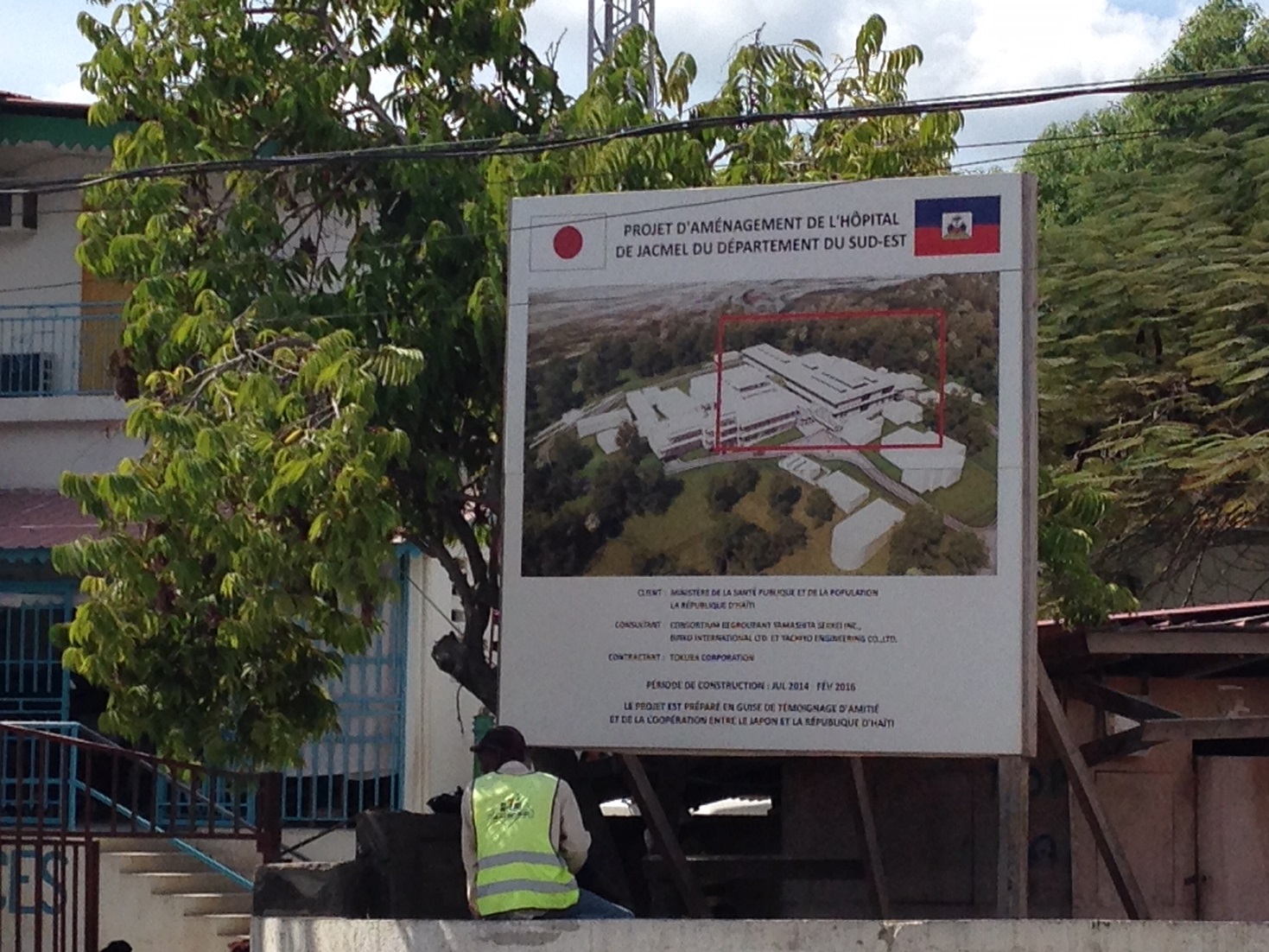
(Project panel for the under construction St. Michel Hospital, Jacmel)
When I was posted in Haiti, I was lucky to be there exactly when the Hôpital St. Michel in the city of Jacmel, around three hours from Port au Prince in the Southeast Department, was safely completed. St. Michel was urgently rebuilt with the funds of the Japanese government, the Canadian Red Cross and U.S. Red Cross as a key hospital in the Southeast Department, with the ability to accept patients from lower level hospitals and health centers who have serious injuries and illnesses and need complex and advanced medical attention. High expectations were placed on its function as a center hospital in the Department to enhance the overall medical system and human resource capacity.
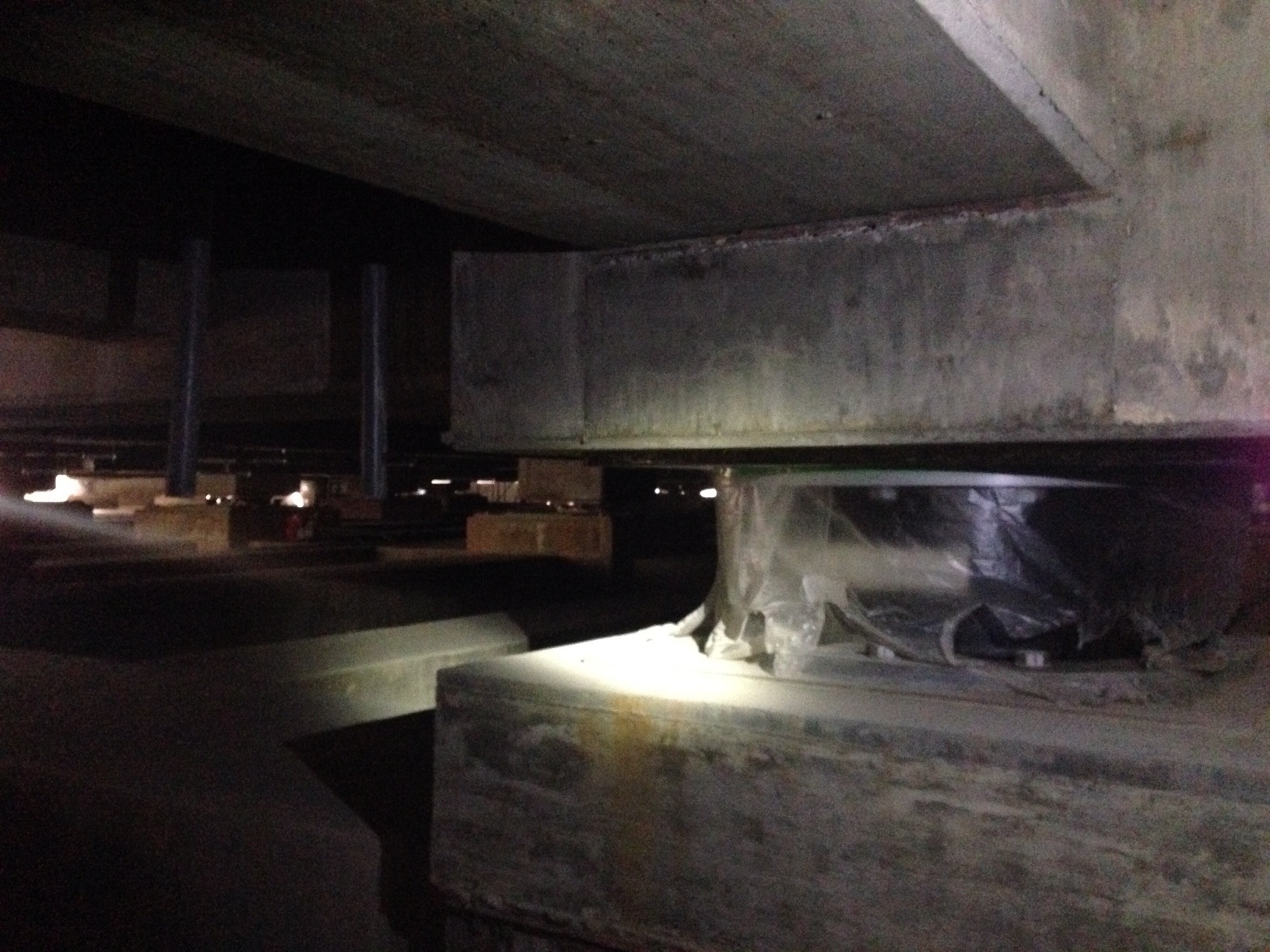
(Seismic isolator of the St. Michel Hospital)
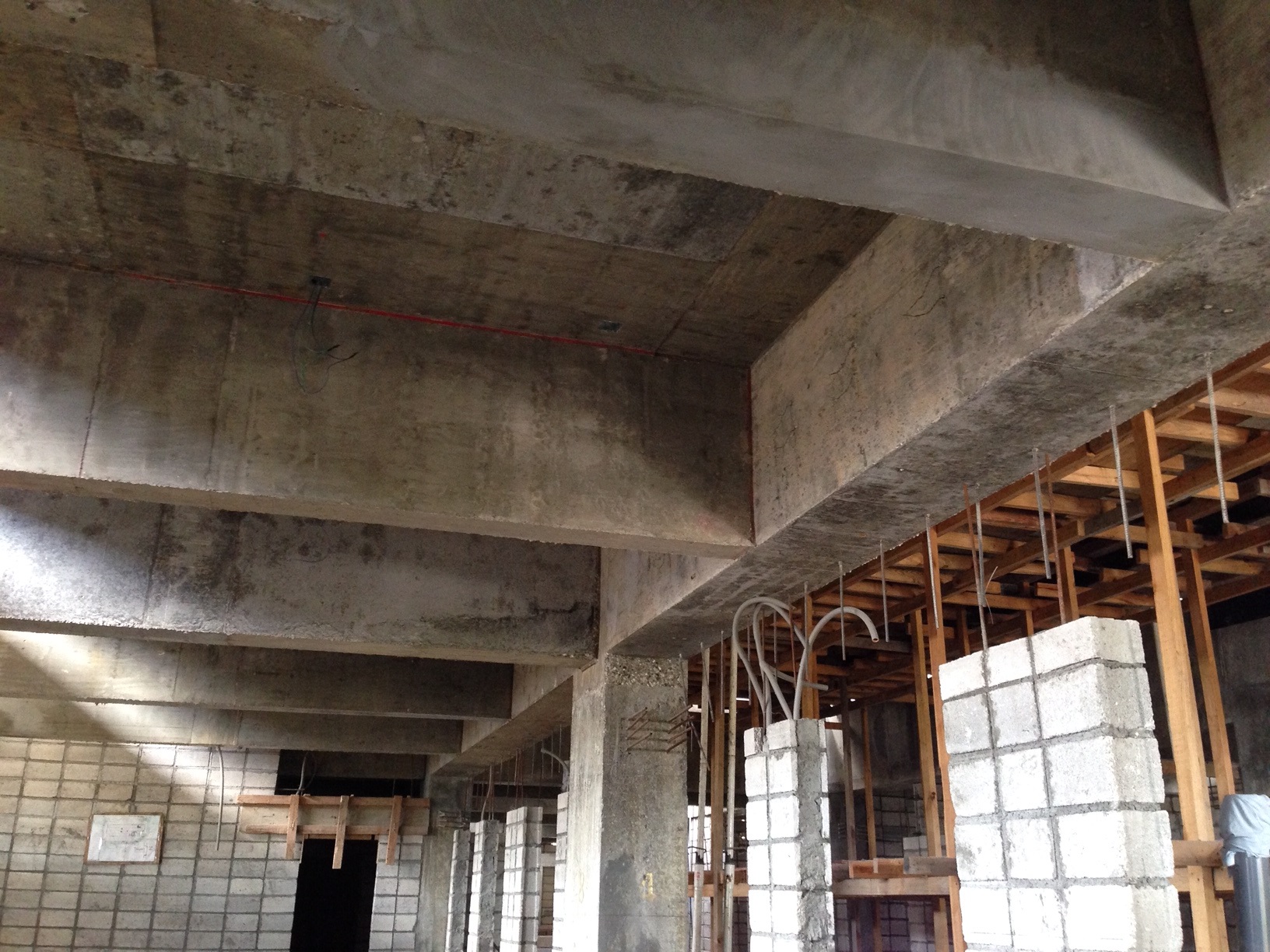
(Strong pillars and beams supporting the structure of the hospital)
I had the honor to join the Canadian Ambassador and Canadian Red Cross Haiti Representative, US Red Cross Representative, Haiti Red Cross Representative, the First Lady, and the Health and Population Minister at the September 2016 ribbon-cutting ceremony. The hospital was a very impressive building, built with the help of Japanese funds and applied Japanese technology, and in addition the residents of Jacmel proactively helped at the construction site to build the new hospital. The ceremony was an opportunity to pray for the use of St. Michel to the fullest extent after completing the mission to rebuild the facility. Deep appreciation was expressed for the Japanese government and Japanese citizens for their support and understanding for the Southeast Department and the nation of Haiti in the health sector.
Furthermore, it is needless to say that one cannot expect much in terms of medical treatment from a hospital by looking at it as a mere container. Once there are proper doctors, nurses, and staff in place, then one can start to have expectations. Fortunately, JICA has in place an Expert Program which secures the continuation of technological cooperation. JICA’s program in Haiti includes working with the ministry on health policies and system implementation, as well as supporting the operation and systems of the Jacmel hospital and giving direct guidance in the maternal and child health sector. As part of JICA’s program in Haiti, local participants involved in JICA’s program are invited to Japan as trainees. In addition, a professor, an authority on maternal and child health of Morocco was dispatched to Haiti (I am happy to say that I have known this professor for some time in Morocco) as part of Trilateral Cooperation program.
As such, using Japan’s strengths and taking an organic and holistic approach is very effective and is the ideal way of executing international cooperation.
In reality, almost everyone (in every country) interacts with the medical and health sector, and on the other hand simultaneously it is the easiest sector where differences are felt in terms of a sense of safety, and medical background points of view (in some cases close to philosophy). Countries have various types of cooperation relations with each other, and consequently it is inevitable that they must take an approach that recognizes that there are facets which they share and others on which they differ. In this respect one can say that when looking at Haiti’s partnership system in detail that it has various issues it needs to resolve. This made it increasingly clearer to me that this is why it is imperative to work with Haiti on a continuous mid to long-term scale and interact at the base level.
In this regard, “slow and steady wins the race” in terms of Japan’s development cooperation has concrete results in the maternal and child health sector in Morocco. This lateral connection in the Francophone world was used in cooperation relationships; letting Haiti blossom in so-called Trilateral Cooperation, or in other words, I believe that JICA’s proactive engagement and the existence and efforts of JICA’s experts played a big part in developing and connecting the dots.
In regards to Jacmel Hospital, Japan has sustained its continuous support in the health administration sector while helping turn the hospital into a model case in terms of bringing in professionals, system implementation and operation. I sincerely hope for the continued cooperation of Japan and Jacmel Hospital, which will become the ‘best practice’ in the sector, and also for the growing maintenance and development of Haiti’s health sector.
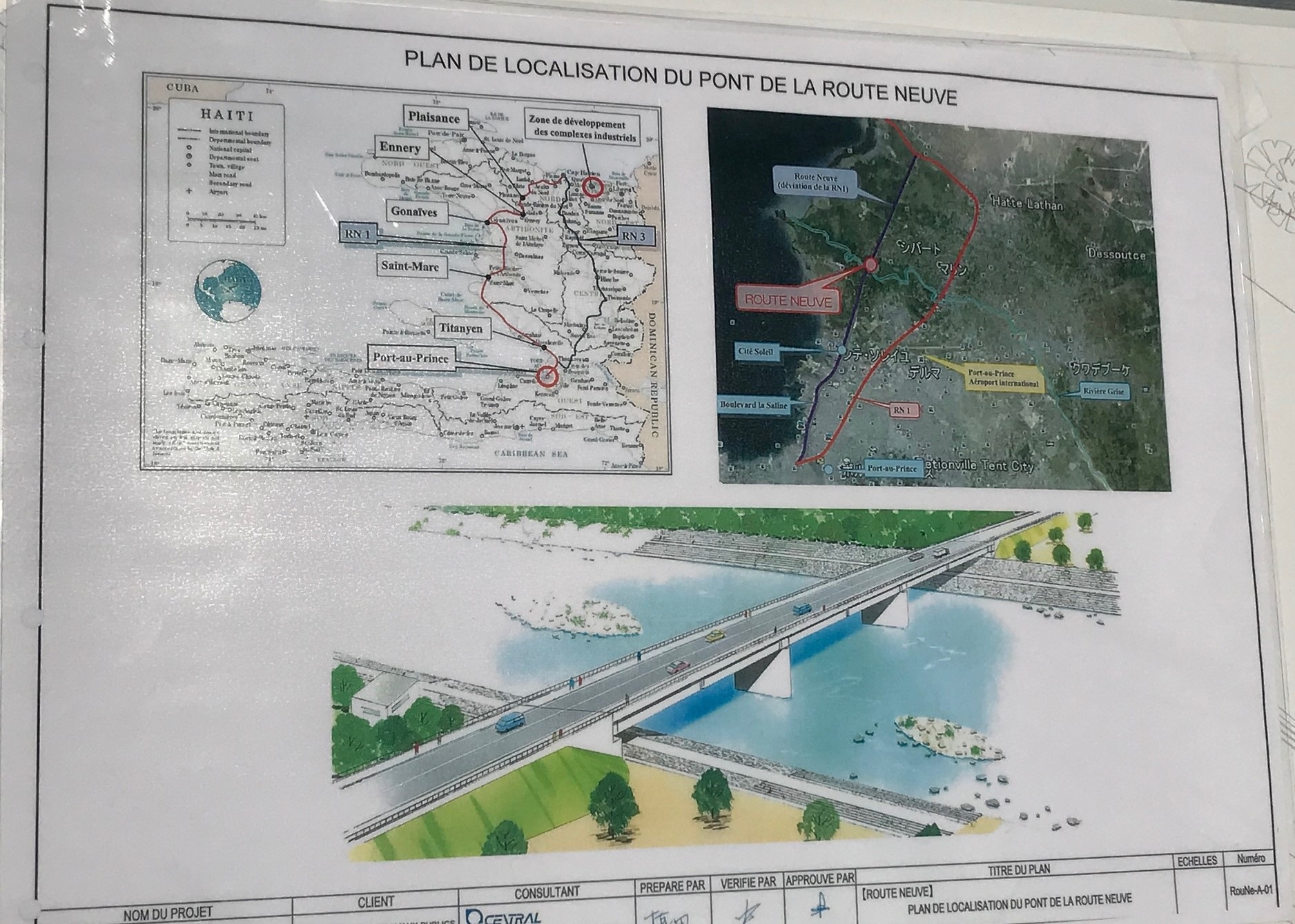
(Panoramic view of new bridge project)
The Croix des Missions Bridge and the Route Neuf Bridge rebuilding projects (two bridges) have been in the works for a while, with signatures from both Japan and Haiti as part of reconstruction support. However, the projects did not move forward for a length of time until it became a necessity due to the dangers brought on by deterioration. Two bridges were to be rebuilt, replacing the old steel bridges with sturdy, concrete ones. The project came about due to Haiti’s strong demand for help in rebuilding the bridges due to safety concerns. The Croix de Mission Bridge crosses the Riviere Grise (=Gray River) on the National Highway Route 1, which goes from Port au Prince to the northern beach resort area of Haiti, and the Route Neuf Bridge crosses on the bypass Route 9 on its way. There are a few reasons why the project took a while to launch; the roads are highly-trafficked, and there are gangs and other groups working behind the scenes in that area, creating an unsafe environment after the earthquake making it difficult to start work on the project.
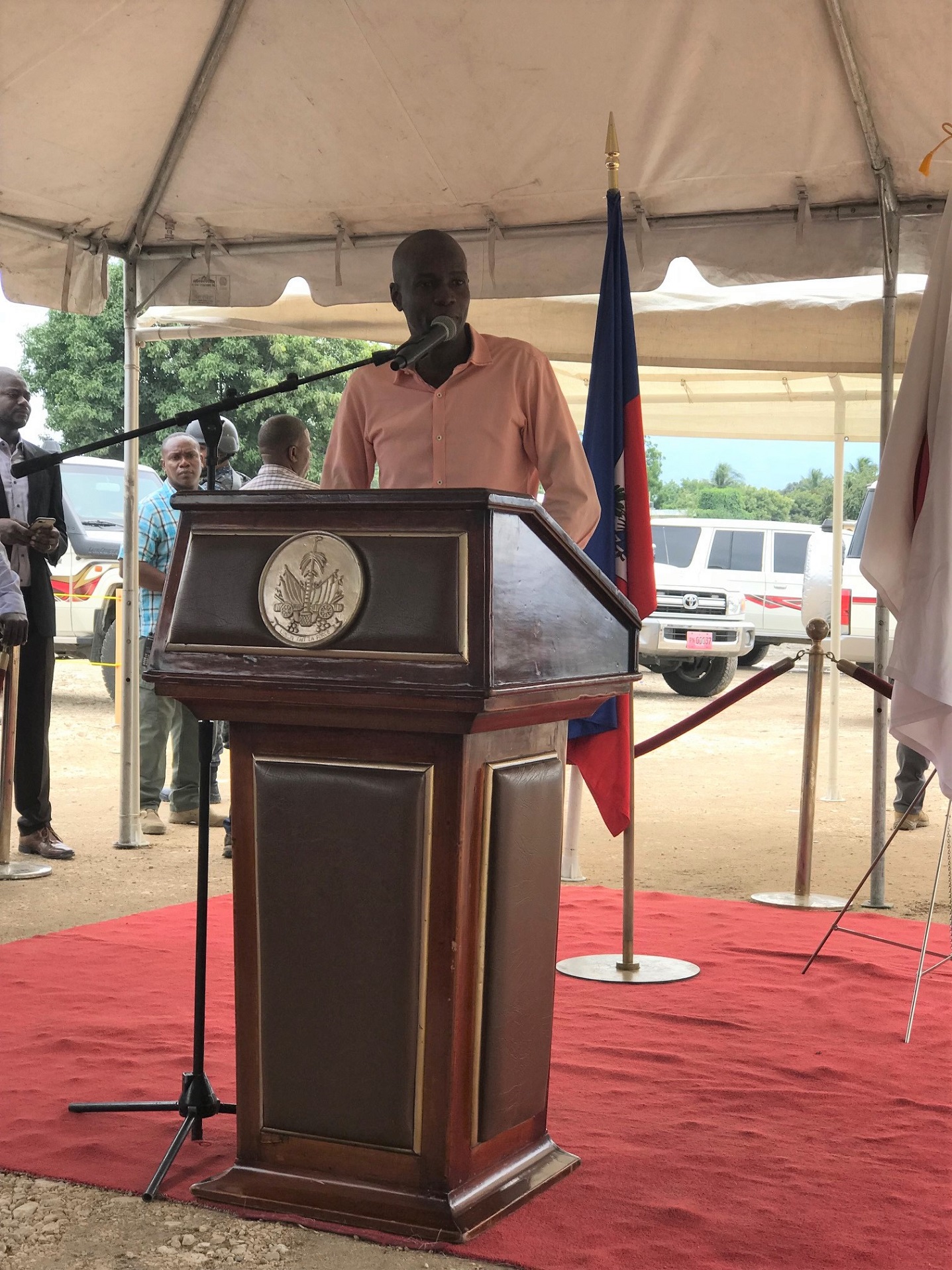
(President Moïse giving a speech at the foundation stone laying ceremony of the Croix des Missions bridge project)
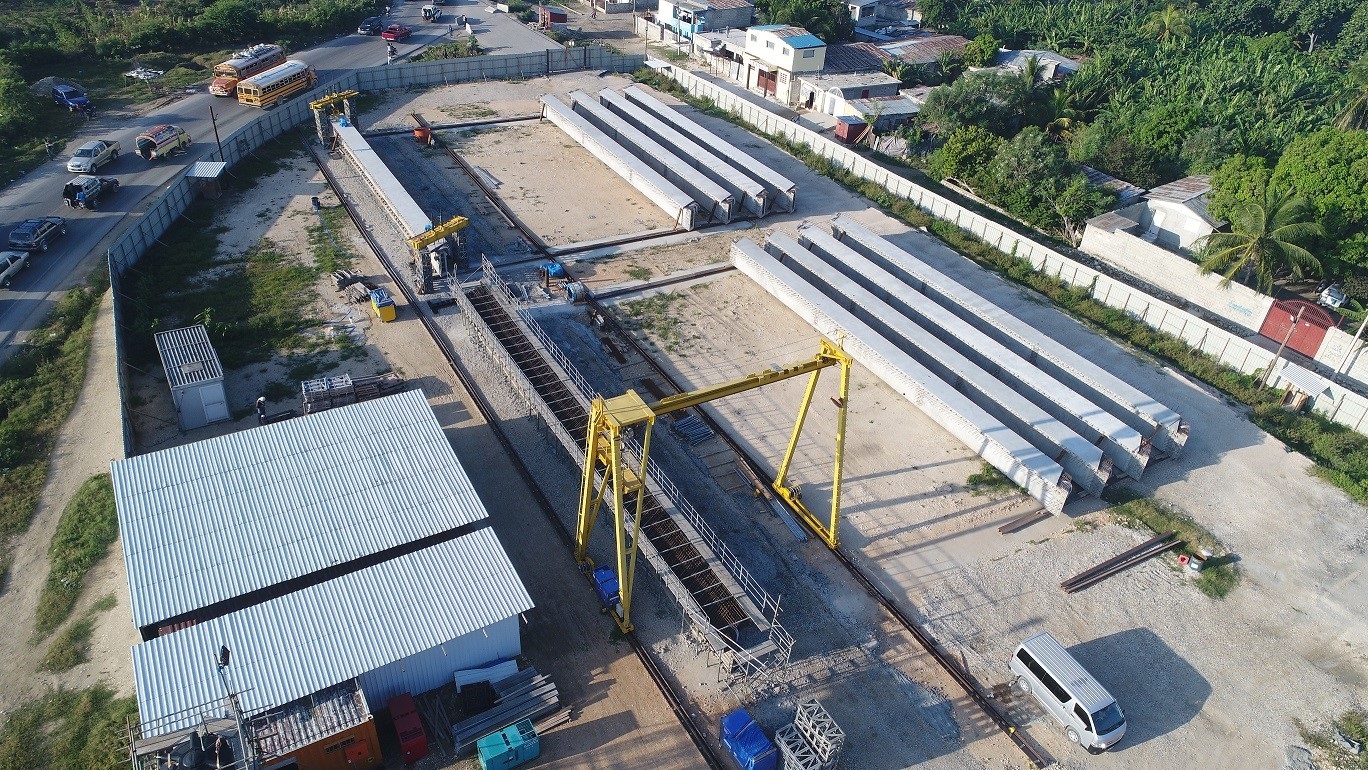
(Panoramic view of bridge construction yard)
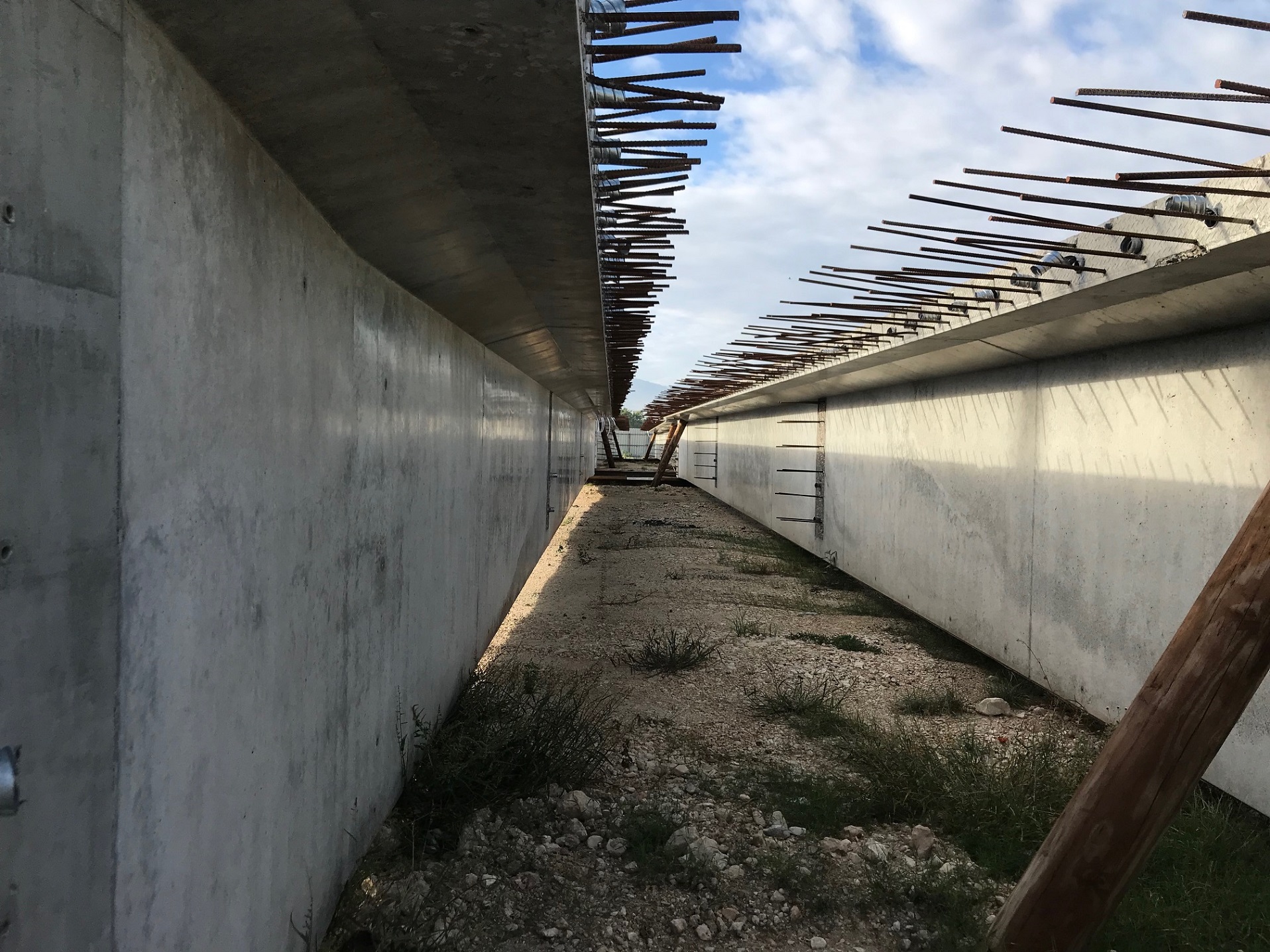
(Prestressed concrete pillars for bridge)
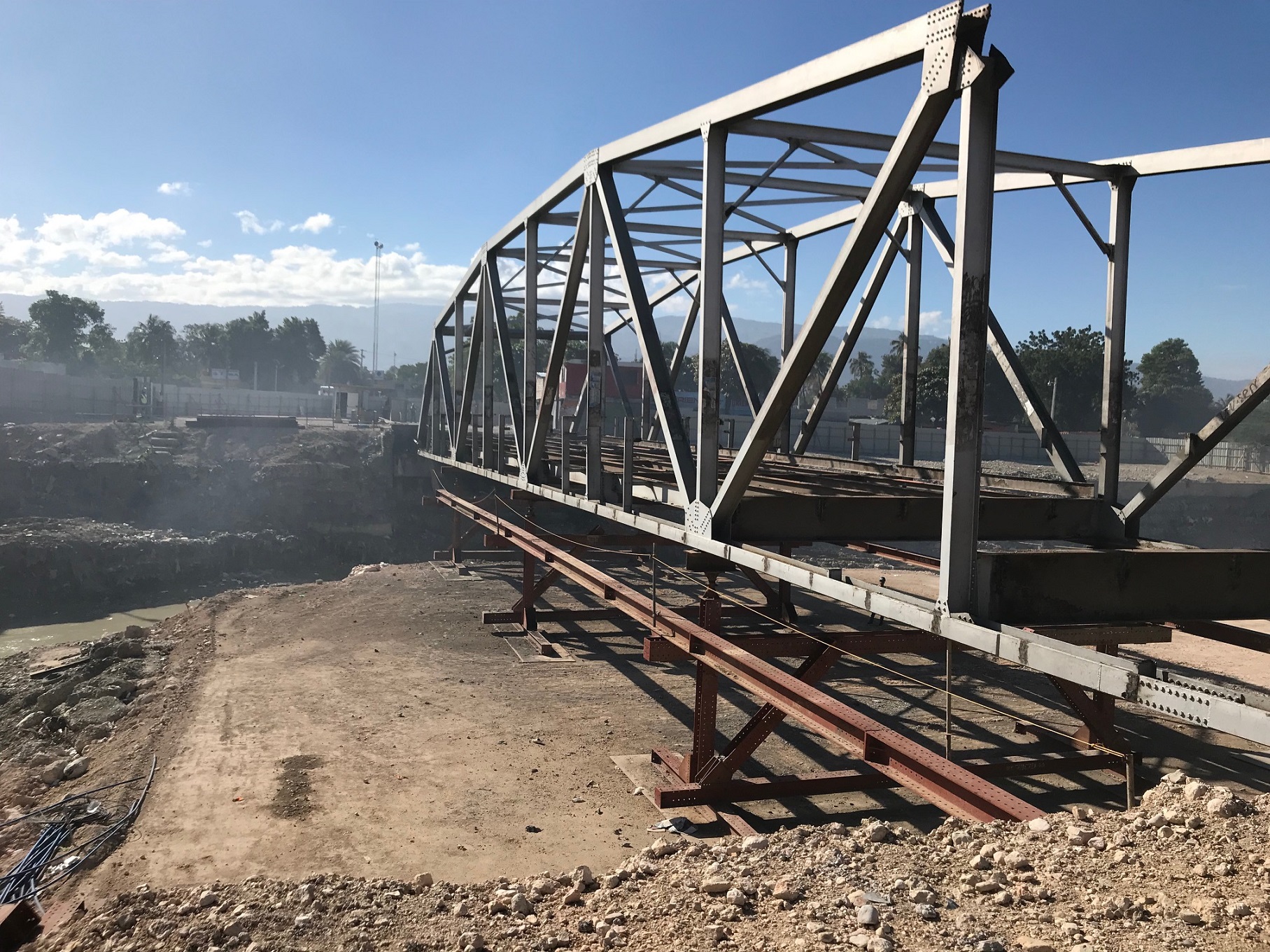
(Removing old steel bridge at Croix des Missions to make way for replacement)
As you can tell, although this project is under the category of Grant Aid Project, there are various areas which for those who are involved are of great reference, such as safety on a Japanese worksite (I heard through the grapevine that it was a struggle to get workers to wear safety helmets at all times), management on work scheduling and process, etc.
The bridges are still under construction at this moment. I am (from Japan) looking forward to the completion of two splendid bridges.
(Part 2)
(*All photos taken by the author)
(*This column reflects the personal views of the author and not the opinions of their employer)
Backnumbers are here
WHAT'S NEW
- 2025.8.28 UPDATE
PROJECTS
"Barbados A Walk Through History Part 16"
- 2025.5.15 UPDATE
EVENTS
"417th Lecture Meeting Regarding Global Issues"
- 2025.4.17 UPDATE
EVENTS
"416th Lecture Meeting Regarding Global Issues"
- 2025.3.13 UPDATE
EVENTS
"415th Lecture Meeting Regarding Global Issues"
- 2025.2.20 UPDATE
EVENTS
"414th Lecture Meeting Regarding Global Issues"
- 2025.2.12 UPDATE
PROJECTS
"Barbados A Walk Through History Part 15"
- 2025.1.16 UPDATE
EVENTS
"413th Lecture Meeting Regarding Global Issues"
- 2024.12.19 UPDATE
EVENTS
"412th Lecture Meeting Regarding Global Issues"
- 2024.12.4 UPDATE
PROJECTS
"Barbados A Walk Through History Part 14"




